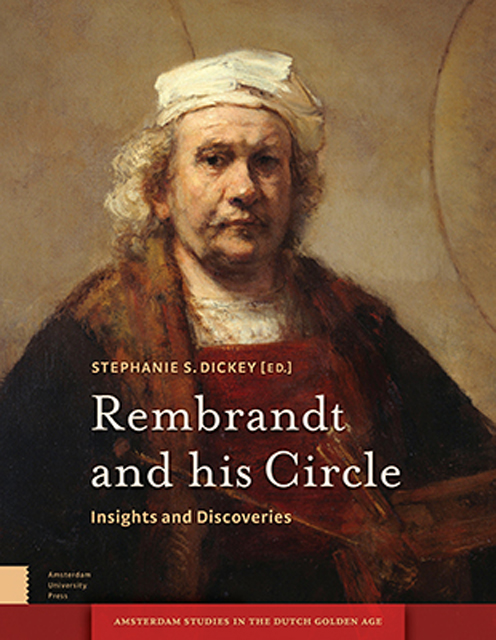Book contents
- Frontmatter
- Dedication
- Contents
- Acknowledgements
- Introduction
- 1 Rembrandt and Frans Hals Painting in the Workshop of Hendrick Uylenburgh
- 2 Rembrandt and the Germanic Style
- 3 Rembrandt and the Humanist Ideal of the Universal Painter
- 4 Curiosity and Desire: Rembrandt’s Collection as Historiographic Barometer
- 5 Painted Landscapes by Lievens and Rembrandt : The View from Seventeenth-Century Amsterdam Collections
- 6 Jan Lievens in Antwerp: Three Rediscovered Works
- 7 Gerrit Dou as a Pupil of Rembrandt
- 8 A New Painting by Jan van Noordt in Budapest
- 9 Rembrandt’s First Nude? The Recent Analysis of Susanna and the Elders from Rembrandt’s Workshop
- 10 Rembrandt’s Head of Christ: Some Technical Observations concerning Matters of Style
- 11 A Rediscovered Head of John the Baptist on a Platter from Rembrandt’s Studio
- 12 Rembrandt’s One Guilder Print: Value and Invention in ‘the most beautiful [print] that ever came from the burin of this Master’
- 13 Rembrandt, Ferdinand Bol, and Tobit: The Emergence of a Pathosträger
- 14 Biblical Iconography in the Graphic Work of Rembrandt’s Circle
- 15 Jan van Vliet and Rembrandt van Rijn: Their Collaboration Reassessed
- 16 Printmaking among Artists of the Rembrandt School
- 17 Chain Line Pattern Matching and Rembrandt’s Prints
- List of Illustrations
- Bibliography
- Index Nominum
7 - Gerrit Dou as a Pupil of Rembrandt
Published online by Cambridge University Press: 21 January 2023
- Frontmatter
- Dedication
- Contents
- Acknowledgements
- Introduction
- 1 Rembrandt and Frans Hals Painting in the Workshop of Hendrick Uylenburgh
- 2 Rembrandt and the Germanic Style
- 3 Rembrandt and the Humanist Ideal of the Universal Painter
- 4 Curiosity and Desire: Rembrandt’s Collection as Historiographic Barometer
- 5 Painted Landscapes by Lievens and Rembrandt : The View from Seventeenth-Century Amsterdam Collections
- 6 Jan Lievens in Antwerp: Three Rediscovered Works
- 7 Gerrit Dou as a Pupil of Rembrandt
- 8 A New Painting by Jan van Noordt in Budapest
- 9 Rembrandt’s First Nude? The Recent Analysis of Susanna and the Elders from Rembrandt’s Workshop
- 10 Rembrandt’s Head of Christ: Some Technical Observations concerning Matters of Style
- 11 A Rediscovered Head of John the Baptist on a Platter from Rembrandt’s Studio
- 12 Rembrandt’s One Guilder Print: Value and Invention in ‘the most beautiful [print] that ever came from the burin of this Master’
- 13 Rembrandt, Ferdinand Bol, and Tobit: The Emergence of a Pathosträger
- 14 Biblical Iconography in the Graphic Work of Rembrandt’s Circle
- 15 Jan van Vliet and Rembrandt van Rijn: Their Collaboration Reassessed
- 16 Printmaking among Artists of the Rembrandt School
- 17 Chain Line Pattern Matching and Rembrandt’s Prints
- List of Illustrations
- Bibliography
- Index Nominum
Summary
Abstract
This essay presents a close visual analysis of several paintings from Rembrandt's Leiden workshop that the author has studied in the course of conservation treatment. Examination of a series of paintings in chronological order reflects the daily practice of a painter in training over several years, a subject about which little is known. In this case, attention to Gerrit Dou's early training as a glass painter can provide clues to the development of his painting technique. This leads to the attribution of several paintings from the period 1628–1631 as created by the young Dou while still in Rembrandt's studio. Paintings associated with Dirk Lievens, Jacques des Rousseaux, Isaac de Jouderville, and Jacob van Spreeuwen are also considered.
Keywords: Gerrit Dou, Rembrandt van Rijn, Dirk Lievens, Isaac de Jouderville, Jacques des Rousseaux, Jacob van Spreeuwen, Jan Lievens, glass painting
Among all the pupils of Rembrandt, only one had his first day in the master's studio recorded. In his description of the town of Leiden, Jan Jansz Orlers claims that Dou started his apprenticeship on 14 February 1628. It is thus ironic that Dou's progress as a pupil has not been traced in any known works, the more so given his subsequent breathtaking rise to fame. The task is admittedly challenging. There is no further documentation of his training, which lasted until 1631, and, of course, there are no signed and dated works from this period. Based on the close stylistic analysis of a substantial number of paintings hitherto considered the work of anonymous Rembrandt pupils of the Leiden period, conducted in the process of conservation treatment, the author proposes to identify a cohesive group of paintings as the product of Dou's period of study with Rembrandt.
Good quality anonymous paintings provoke academic curiosity. A case in point and of particular interest for the subject of this essay is Anna with the Blind Tobit in the National Gallery in London. From the late nineteenth century to present day, it has alternated between Rembrandt and Gerrit Dou. Today, many of the respective experts on both artists firmly reject it.
- Type
- Chapter
- Information
- Rembrandt and his CircleInsights and Discoveries, pp. 169 - 188Publisher: Amsterdam University PressPrint publication year: 2017



